

Welcome to Jodhpur, the mesmerizing “Blue City” of Rajasthan, India! Nestled amidst the golden sands of the Thar Desert, Jodhpur is a vibrant tapestry of ancient forts, majestic palaces, serene temples, and bustling bazaars, all painted in captivating shades of blue. Its timeless charm, rich history, and azure landscapes make it an unmissable destination for any traveler seeking an authentic Indian experience.
Jodhpur, also fondly known as the “Sun City” due to its consistently sunny weather, was founded in 1459 by Rao Jodha, a Rajput chief of the Rathore clan. Strategically located on the ancient silk trade routes, the city quickly flourished as a center of commerce and culture. Its history is intertwined with the grandeur of the Mughal Empire and the fierce independence of the Rajput warriors. Today, Jodhpur stands as a testament to its glorious past, offering a unique blend of architectural marvels, soulful stories, and enchanting cultural encounters.
Whether you’re a history buff, a culture enthusiast, a food lover, or an adventurer, Jodhpur promises an unforgettable journey. This comprehensive guide will help you navigate the city’s hidden gems and iconic landmarks, ensuring you make the most of your visit to this magical blue wonderland.
Jodhpur is well-connected to major Indian cities, making it easily accessible by various modes of transport.
Once you’re in Jodhpur, getting around is relatively easy. Auto-rickshaws and tuk-tuks are readily available and are a fun way to navigate the narrow lanes of the old city. Ride-sharing apps like Uber are also present, offering a convenient option. For those feeling adventurous, exploring the old city on foot is highly recommended to truly soak in its atmosphere.
To truly experience the essence of Jodhpur, plan to spend at least three to four magical days exploring its myriad attractions. Here are the top things to do that should be on every traveler’s itinerary:

Undoubtedly the most iconic landmark, Mehrangarh Fort is a colossal structure that dominates the Jodhpur skyline, perched atop a 400-foot-high hill. Built in 1459 by Rao Jodha, this magnificent fort is one of the largest and best-preserved forts in India, showcasing exquisite Rajput architecture and intricate carvings.
As you ascend the fort, you’ll pass through seven gates, each bearing historical significance. Inside, explore a labyrinth of courtyards, palaces, and museums. Don’t miss:
For the adventurous, consider zip-lining across the fort’s ramparts with Flying Fox, offering thrilling views of the Blue City. After your exploration, unwind at one of the cafes within the fort, like Café Mehran or Chokelao Mahal Terrace, and soak in the panoramic vistas.
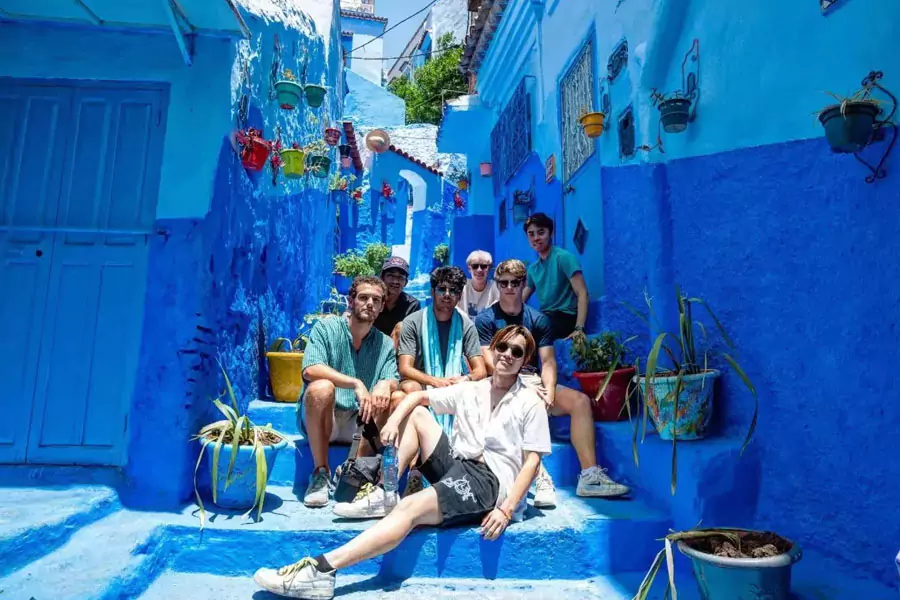
The most charming aspect of Jodhpur is its Old City, a maze of narrow, winding lanes where houses are painted in various shades of blue. This unique tradition, believed to be associated with Brahmins (the priestly caste) or as a way to keep houses cool in the desert heat, creates a surreal and picturesque landscape.
Let children guide you through the Blue Corridor: Some local children might offer to guide you through the intricate alleys, sharing their local knowledge and leading you to the best photo spots. This can be a delightful and authentic interaction. Spend hours getting lost in these vibrant streets, capturing stunning photographs, and observing local life.
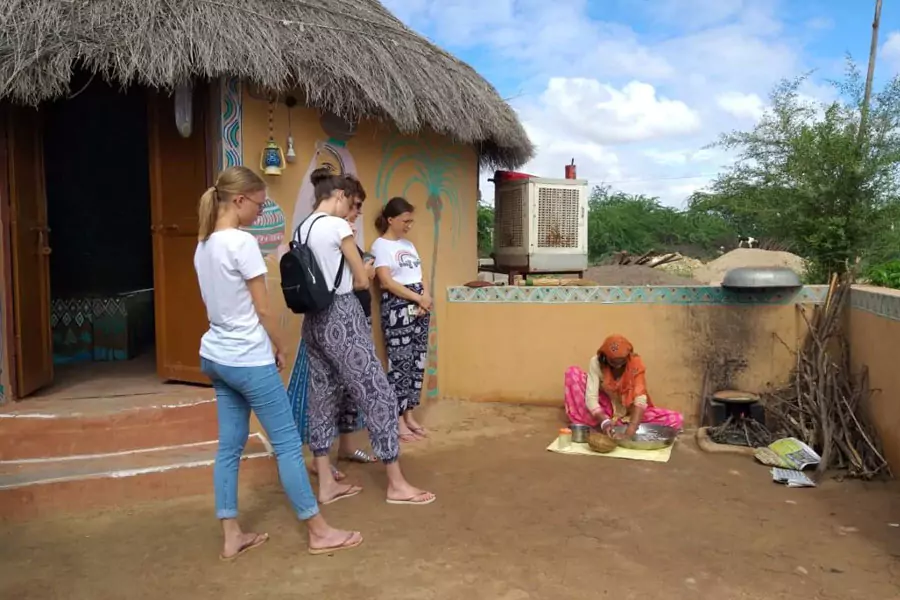
Embark on a unique Bishnoi Village Safari to experience the rural life and environmental ethos of the Bishnoi community. This eco-conscious Hindu sect, known for their reverence for nature and wildlife, lives in harmony with their surroundings. The safari typically includes visits to:
This tour offers a profound insight into a sustainable lifestyle deeply rooted in respect for the environment.

A magnificent blend of Eastern and Western architecture, the Umaid Bhawan Palace is one of the world’s largest private residences. Part of the palace still serves as the residence of the erstwhile royal family, another part has been converted into a luxurious Taj Hotel, and a section is open to the public as a museum.
The museum showcases royal artifacts, vintage cars, clocks, and photographs, providing a glimpse into the opulent lifestyle of the Maharajas. Its grand scale and impressive design make it a must-visit, offering a stark contrast to the ancient fort.
Ticket Prices: ₹30 for locals, ₹100 for international visitors; ₹150 for guided tours.
Tip: Book a guided tour to fully appreciate the palace’s history and architecture.
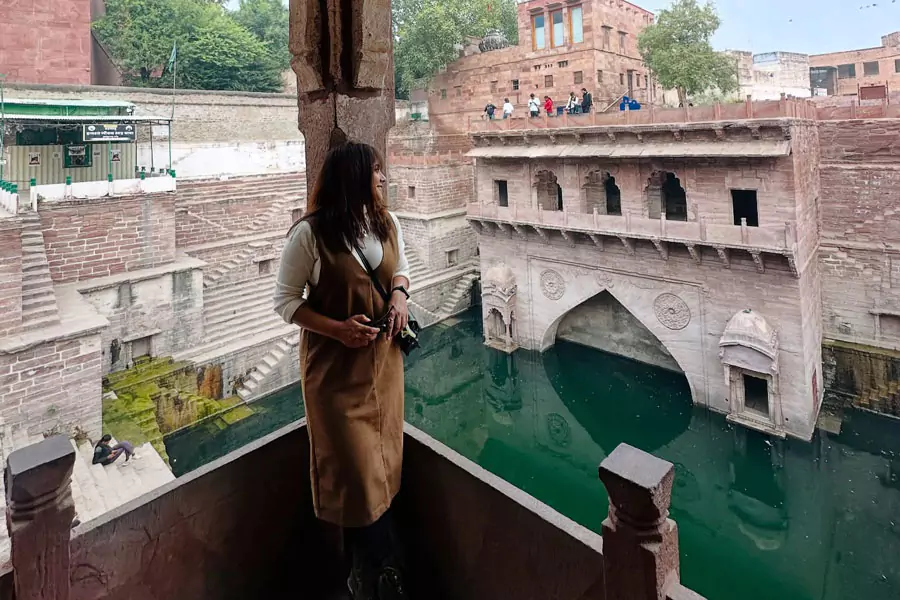
The Toorji Ka Jhalra Bavdi, a 300-year-old stepwell, is a remarkable example of Jodhpur’s ancient water harvesting systems. Recently restored, this architectural marvel features intricate carvings and a complex network of steps leading down to the water. It’s a fantastic spot for photography and to observe local life, as children often jump into the cool water during hotter months. The Stepwell Cafe nearby offers a perfect vantage point for enjoying refreshments with a view of this historical structure.
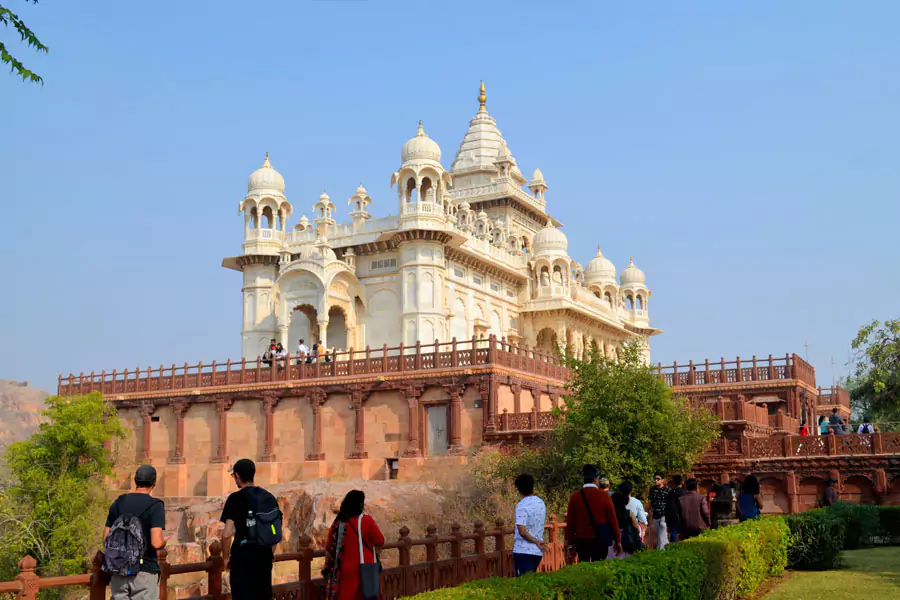
Located near the Mehrangarh Fort, Jaswant Thada is an exquisite marble cenotaph built in 1899 in memory of Maharaja Jaswant Singh II. Often referred to as the “Taj Mahal of Marwar,” its intricate marble lattice work and serene ambiance make it a peaceful retreat. The memorial is surrounded by beautifully manicured gardens and offers panoramic views of the fort and the city.
Ticket Prices: ₹30 for locals, ₹50 for foreign visitors.
Tip: Combine with a Mehrangarh Fort visit for a full day of exploration.
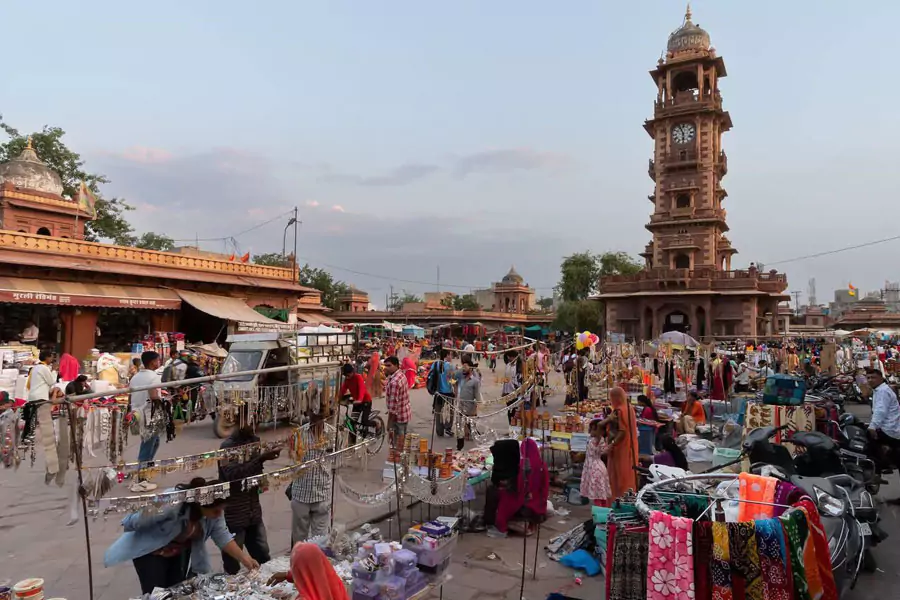
The bustling Sardar Market, crowned by the iconic Ghanta Ghar (Clock Tower), is the heart of Jodhpur’s old city. This vibrant market is a sensory delight, offering everything from spices, textiles, and handicrafts to traditional Rajasthani jewelry, turbans, and antiques.

For an unforgettable experience, find a rooftop restaurant in the old city, such as Castle View, Indique, or Blue Bird, and enjoy dinner while watching the sun set behind the colossal Mehrangarh Fort. The fort glows in a golden hue as the sky changes colors, creating a magical silhouette that will be etched in your memory.
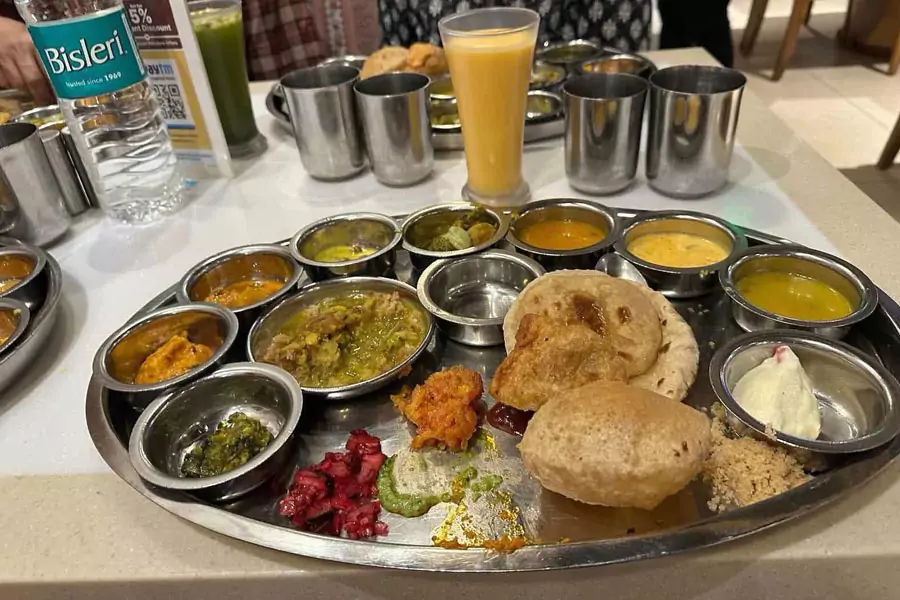
Jodhpur’s culinary scene is a treat for the taste buds, offering a delightful array of Rajasthani dishes.
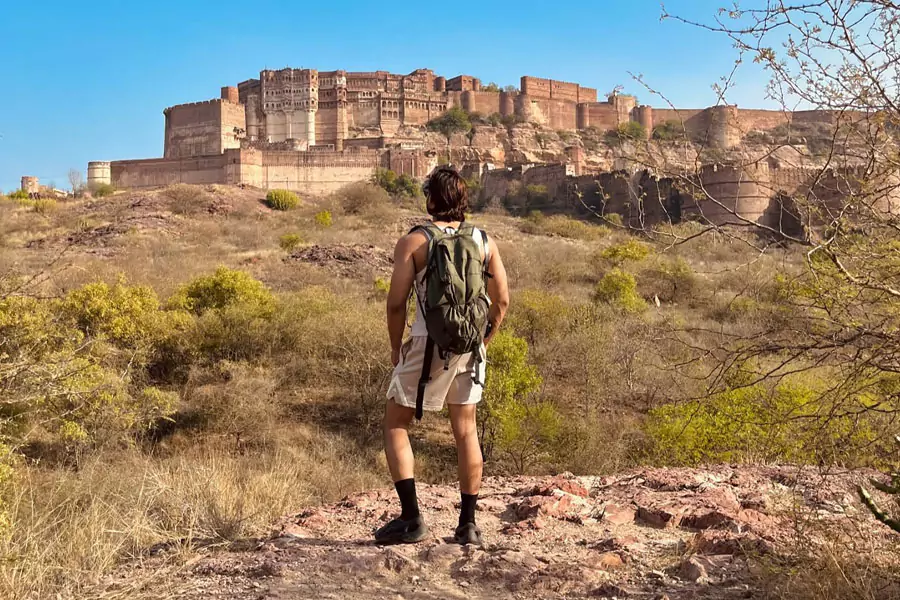
Beyond the ancient walls and bustling bazaars, Jodhpur offers a surprising natural retreat: the Rao Jodha Desert Rock Park. Located right at the foot of the mighty Mehrangarh Fort, this innovative ecological initiative was established to rehabilitate a large, rocky wasteland. What was once barren land has been meticulously transformed into a thriving ecosystem showcasing the native desert flora and unique geology of the Thar Desert region.
This isn’t just a garden; it’s a living exhibition of Rajasthan’s natural heritage. As you wander along the meticulously maintained walking trails, you’ll encounter a diverse array of indigenous plants, many of which are rarely seen elsewhere. Interpretive signboards provide fascinating insights into their ecological significance and traditional uses. The park’s design thoughtfully integrates with the existing rock formations, creating a landscape that is both ruggedly beautiful and serene. It’s an ideal spot for nature enthusiasts, photographers, or anyone seeking a tranquil escape from the city’s vibrant energy. The tranquility here offers a stark, yet beautiful, contrast to the historical grandeur of the fort towering above it, making it a perfect spot for quiet reflection or a leisurely stroll after exploring Mehrangarh Fort. You might even spot some local wildlife adapted to this arid environment.

Just about 8 kilometers west of Jodhpur’s city center lies Kaylana Lake, a picturesque artificial lake that serves as a vital water source for the region and a popular recreational spot. Built in 1872 by Pratap Singh, this expansive lake offers a refreshing respite from the desert heat and the urban bustle.
Kaylana Lake is particularly renowned for its breathtaking sunsets. As the sun dips below the horizon, painting the sky in fiery hues, the calm waters of the lake reflect the spectacle, creating a truly magical moment. It’s a favorite picnic spot for locals and a growing attraction for tourists seeking peace and natural beauty. For those looking for a bit more activity, boating facilities are available, allowing you to glide across the serene waters and enjoy the surrounding landscape from a different perspective. Birdwatchers will also appreciate the chance to spot various migratory and local bird species that frequent the lake. A visit here offers a perfect blend of relaxation and natural beauty, making it a highly recommended addition to your Jodhpur itinerary for a peaceful evening.
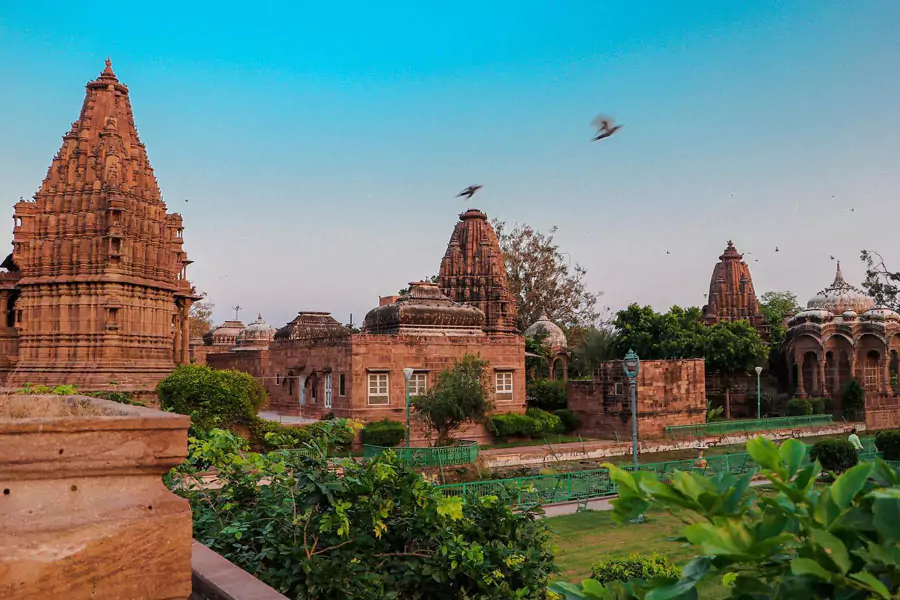
Just 9 kilometers north of Jodhpur, you’ll discover the enchanting Mandore Gardens. This historical site holds significant importance as the former capital of the Marwar region before Jodhpur was founded. Today, it’s a sprawling complex of beautifully landscaped gardens, ancient temples, and intricately carved cenotaphs (memorials) dedicated to the Maharajas of Jodhpur.
What sets Mandore Gardens apart is its unique blend of history and horticulture. The lush greenery, vibrant flowers, and trickling water features provide a refreshing contrast to the arid desert landscape outside. The highlight of the gardens is the Hall of Heroes, a gallery housing sixteen colossal figures carved out of a single rock, depicting popular Rajput folk deities and heroes. Nearby, you’ll find the majestic cenotaphs, which are architecturally distinct from the typical Rajput palaces. Built in the style of Hindu temples, with multi-tiered spires and elaborate carvings, they are a photographer’s delight. Exploring Mandore Gardens offers a tranquil escape and a deeper insight into the rich cultural and artistic heritage of the Rathore rulers. It’s a perfect half-day trip to immerse yourself in history amidst natural beauty.
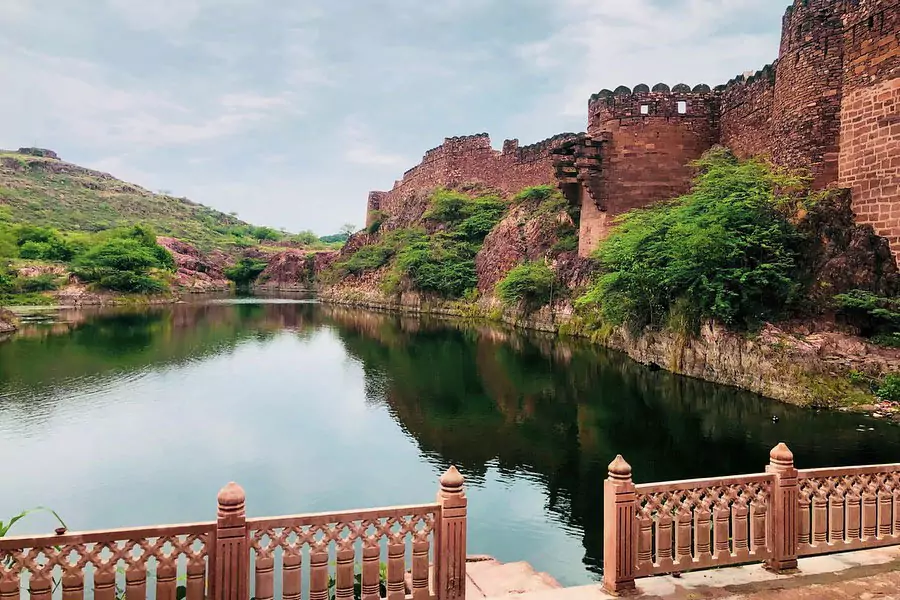
Nestled right at the foot of the colossal Mehrangarh Fort, you’ll find the twin ancient lakes of Ranisar and Padamsar. While they may not be as grand or as popular for boating as Kaylana Lake, their historical significance and serene presence make them a fascinating stop on your Jodhpur exploration. These lakes were once the primary sources of water for the mighty Mehrangarh Fort and the surrounding city, a testament to the ingenious water management systems of ancient Rajasthan.
The lakes offer a tranquil respite from the bustling activity of the fort and the markets. Surrounded by the rugged beauty of the desert landscape and with the imposing fort walls as a backdrop, they provide a peaceful atmosphere for quiet contemplation or a leisurely stroll along their banks. They are particularly picturesque early in the morning or late in the afternoon when the light is soft, offering unique photographic opportunities of the fort reflected in the calm waters. Discovering these ancient reservoirs provides a deeper appreciation for the historical challenges and resourceful solutions employed by the people of Jodhpur through the centuries.

For an unexpected and awe-inspiring wildlife encounter, keep your eyes on the skies around Mehrangarh Fort. The majestic eagles and various other birds of prey are a common and captivating sight, circling high above the fort’s ancient ramparts. This unique phenomenon is often enhanced by locals, particularly “Rathore,” the designated fort feeder, who has for generations maintained a tradition of feeding these magnificent birds.
Witnessing the eagles swoop down from the vast blue sky to catch their meal is a truly spectacular display of nature’s raw power and grace. It’s a profound experience for nature lovers, wildlife photographers, and anyone looking for a moment of wonder during their Jodhpur visit. The best time to observe this mesmerizing aerial show is typically in the late afternoon. This unique interaction between man and nature adds another layer to the already rich tapestry of experiences available at one of India’s grandest forts, making it an unforgettable highlight of your trip.

While the Sardar Market at the Ghanta Ghar is undeniably famous and a must-visit for its vibrant energy, don’t limit your Jodhpur shopping experience there. Just a short walk away, you’ll discover Tripolia Bazaar, an equally fascinating and often more authentic shopping destination. This bustling market is renowned for its specific offerings and provides a deeper dive into the local craftsmanship and trade.
Tripolia Bazaar is especially known for its exquisite range of traditional Rajasthani crafts, particularly lac bangles (lacquer bangles). You’ll find a kaleidoscope of colors and designs, from simple elegant pieces to intricately embellished sets, perfect as souvenirs or personal adornments. Beyond bangles, the market also offers a wide array of textiles, including tie-dye (bandhani) fabrics, vibrant traditional attire, and embroidered goods. It’s an excellent place to practice your bargaining skills and find unique, locally made items that reflect the rich artistic heritage of Rajasthan. Shopping in Jodhpur Tripolia Bazaar provides a more local and immersive experience, allowing you to interact directly with artisans and vendors and uncover truly unique Jodhpur souvenirs.
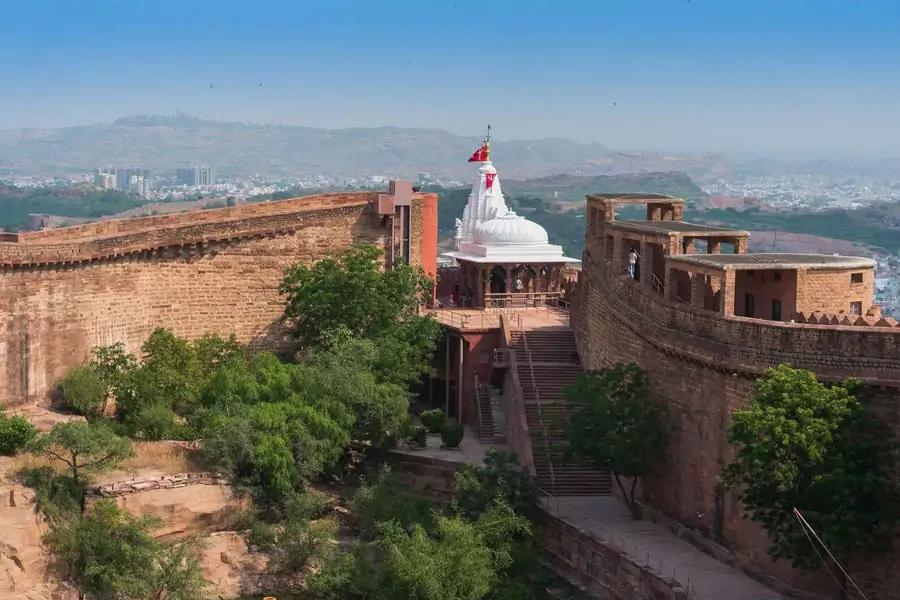
Within the imposing walls of the Mehrangarh Fort complex, perched strategically at one of its extremities, lies the revered Chamunda Mata Temple. This isn’t just another temple; it holds immense cultural and historical significance for the people of Jodhpur, as Chamunda Mata is considered the Kuldevi (family deity) of the Rathore rulers who founded and governed the city.
The temple’s location offers more than just spiritual solace; it provides some of the most spectacular, if lesser-known, panoramic views of the entire Blue City sprawling below. The vibrant blue houses, the labyrinthine lanes, and the distant desert landscape unfold beautifully from this elevated position. Visiting the Chamunda Mata Temple allows you to experience a slice of local faith and tradition. You’ll often find devotees offering prayers and participating in rituals, especially during festivals like Navratri. It offers a moment of spiritual reflection amidst your historical exploration and an opportunity to witness the profound connection between the people of Jodhpur and their protective deity.

For an authentic and unforgettable desert experience, venture beyond Jodhpur to the historic town of Osian, located approximately 65 kilometers away. Often referred to as the “Gateway to the Thar Desert,” Osian offers a perfect opportunity to immerse yourself in the vastness and mystique of Rajasthan’s iconic desert landscape.
The highlight of a visit to Osian is undoubtedly the Desert Safari and Overnight Camping. You can embark on exhilarating camel rides across the rolling sand dunes, feeling like an ancient trader traversing the silk route. For the more adventurous, dune bashing in a 4×4 vehicle offers an adrenaline rush. As evening descends, settle into a comfortable desert camp, where you’ll be treated to traditional Rajasthani dinner served under a canopy of a million stars. The experience is often complemented by vibrant cultural performances, including folk music and dance, creating an enchanting ambiance. Spending a night in the Thar Desert is a truly unique way to connect with the raw beauty of Rajasthan and is a highly recommended extension to your Jodhpur trip.
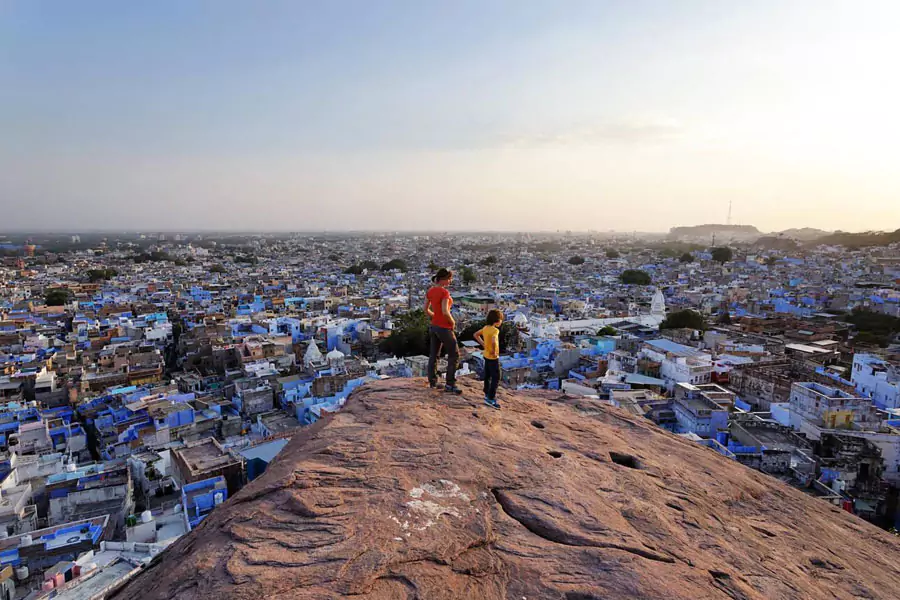
While the Mehrangarh Fort offers quintessential city views, Jodhpur is dotted with numerous smaller temples scattered across its hills and elevated points, many of which serve as secret vantage points for equally fantastic panoramic views of the Blue City. These hidden gems offer a more intimate and serene experience, away from the main tourist crowds.
Exploring these lesser-known temples provides an opportunity for quiet reflection and a chance to truly appreciate the sprawling blue landscape from unique angles. Some require a short hike, rewarding your effort with breathtaking vistas, especially during sunrise or sunset when the soft light bathes the city in a magical glow. These spots are perfect for photographers seeking fresh perspectives or travelers desiring a peaceful moment to soak in Jodhpur’s unique charm. Don’t hesitate to ask locals for recommendations or simply look for small temples perched on higher ground – you might just discover your own favorite hidden viewpoint of Rajasthan’s captivating Blue City.
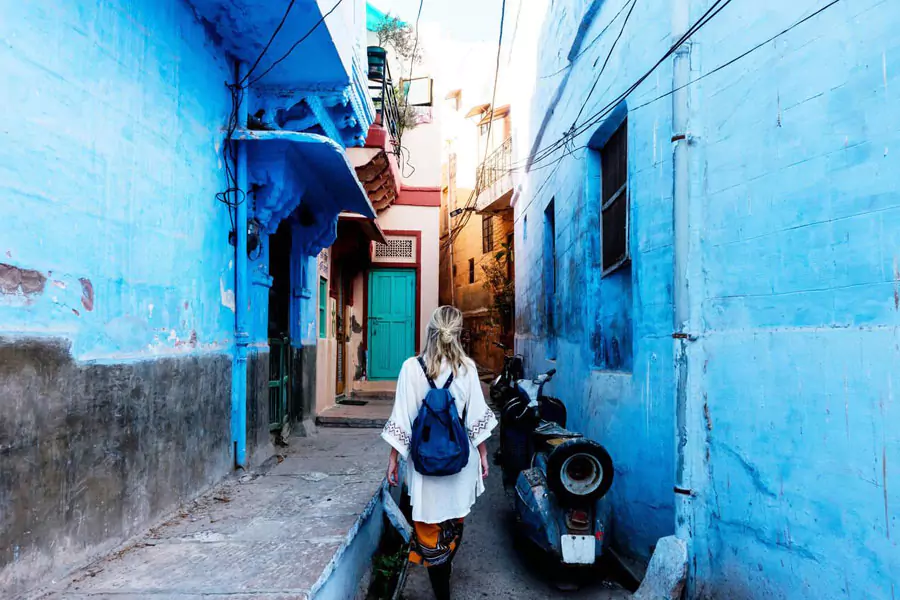
To truly delve into the soul of Jodhpur and move beyond the major tourist attractions, embark on a morning walking tour. This immersive experience is the best way to uncover the authentic rhythm and vibrant pulse of the city’s daily life. As the city awakens, you’ll witness its transformation, from quiet alleys to bustling streets filled with activity.
These guided tours typically take you through the intricate network of the Old City’s narrow lanes, leading you past traditional houses, bustling local markets, aromatic spice shops, and historical Havelis. It’s an unparalleled opportunity to interact with locals, observe their daily routines, and gain unique insights into Jodhpur’s culture, traditions, and heritage. You might stumble upon hidden courtyards, ancient stepwells known only to residents, or witness traditional crafts being practiced. Many tours also include a stop at local eateries to sample authentic Jodhpur street food, like Pyaaz Kachori or Mirchi Vada, giving you a taste of the city’s culinary heart. A morning walking tour is an enriching way to connect with the genuine essence of Jodhpur, making your trip more personal and memorable.

For a truly immersive and authentic Jodhpur experience, forgo modern hotels and opt to stay in a traditional Haveli. These magnificent old family mansions, once the residences of wealthy merchants or nobles, have been lovingly converted into charming heritage hotels and guesthouses. Staying in a Haveli isn’t just about accommodation; it’s about stepping back in time and becoming part of Jodhpur’s living history.
Many of these Havelis are strategically located in the Old City, often near landmarks like the Clocktower Market or the Toorji Ka Jhalra Bavdi stepwell, offering easy access to attractions and a vibrant neighborhood atmosphere. Each Haveli boasts unique architecture, intricate carvings, beautiful courtyards, and sometimes even rooftop restaurants with stunning views of Mehrangarh Fort. The hospitality you receive in a Haveli is typically warm and personal, reflecting the famed Rajasthani hospitality. Budget-friendly options like Jewel Palace Haveli demonstrate that this unique experience is accessible to various travelers. Choosing a Haveli for your stay allows you to sleep within walls steeped in history, providing a tangible connection to Jodhpur’s royal and cultural past, making your visit to the Blue City truly unforgettable.
To ensure a smooth and enjoyable trip to Jodhpur, keep these practical tips in mind:
Jodhpur is more than just a city painted blue; it’s a living museum, a vibrant cultural hub, and a testament to Rajasthan’s rich heritage. From the imposing grandeur of Mehrangarh Fort to the tranquil charm of its stepwells, from the bustling energy of its markets to the serene beauty of its desert landscapes, Jodhpur offers a kaleidoscope of experiences.
So pack your bags, prepare to be enchanted by its azure allure, and embark on an unforgettable journey through the heart of the “Blue City.” Jodhpur awaits you with open arms, ready to reveal its timeless stories and create memories that will last a lifetime.